Who killed Elsie Frost?
- Published
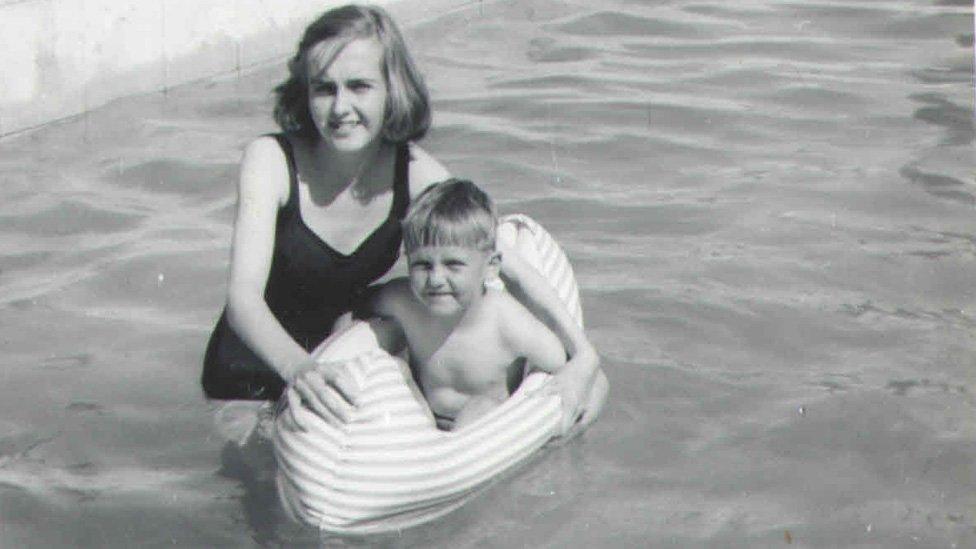
Elsie Frost on holiday in the Isle of Wight
Fifty years ago, 14-year-old Elsie Frost was stabbed to death. A BBC investigation has now led to the police resuming their hunt for her killer.
It was shortly after lunch when Elsie Frost said goodbye to her father, Arthur. She was 14 and was on her way to a lake not far from her home.
It was to be a special occasion. She had been asked to help teach a group of younger children how to sail.
In fact, for Elsie Frost, everything must have seemed rather special at that time. She had some good friends, had just become a member of the local youth club and had been chosen to be the next head girl at her school. Life was getting really good.
Elsie was wearing a yellow woollen sweater, a white blouse and printed cotton skirt.
Before leaving her family's semi-detatched home in Wakefield, she sat down to put on her brand new pair of shoes.
Maybe she checked outside to see if it was cold because she also wrapped herself up in her favourite red, quilted anorak, which had been bought for her by an aunt. Her sailing clothes were in a duffle bag, which she carried over her shoulder.
People who knew her were later to say that she had seemed very happy.
Seven hours later, Elsie Frost's body was lying in Wakefield Public Mortuary being examined by a pathologist. Her white blouse, yellow sweater and favourite red coat were soaked in blood. She had been stabbed several times.
Her father had to identify her body. It was Saturday 9 October 1965.
Elsie's murder dominated the headlines. By the following morning, newspaper journalists had managed to track down her elder sister Anne. She was 18 and was living a few miles away with her husband and son.
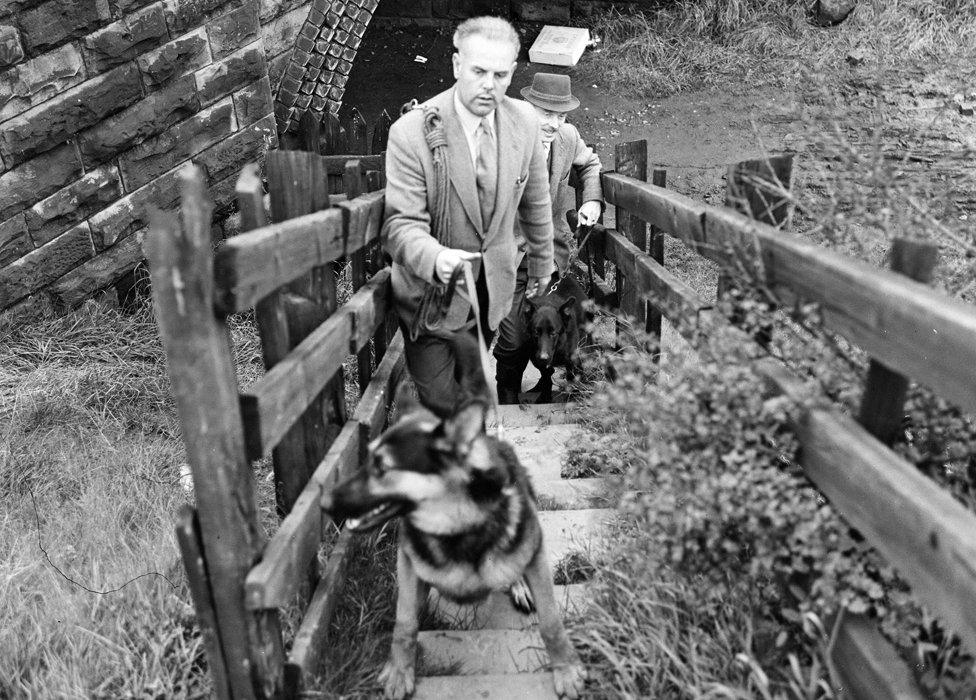
Police at the place where Elsie's body was discovered
By then, Anne's parents were in her house. They had been sedated and were lying down in her bedroom. Some of the reporters were on the "verge of aggressiveness", Anne recalls. Had a policewoman not been with her, she adds, she would not have been able to cope.
Elsie's younger brother, Colin, had first been taken to stay with some neighbours and then to an uncle's house. He was six years old. He remembers still being up on the Monday night when ITN News came on. The first image he saw was Elsie's face. His uncle leapt out of his chair, scooped him up and "zoomed" him up the stairs. Colin has no memory of the time after that point.
The police investigation was huge. Scotland Yard detectives were drafted in to help the local forces in Yorkshire. According to a senior police officer at the time, thousands of people were interviewed and more than 1,200 written statements were taken.
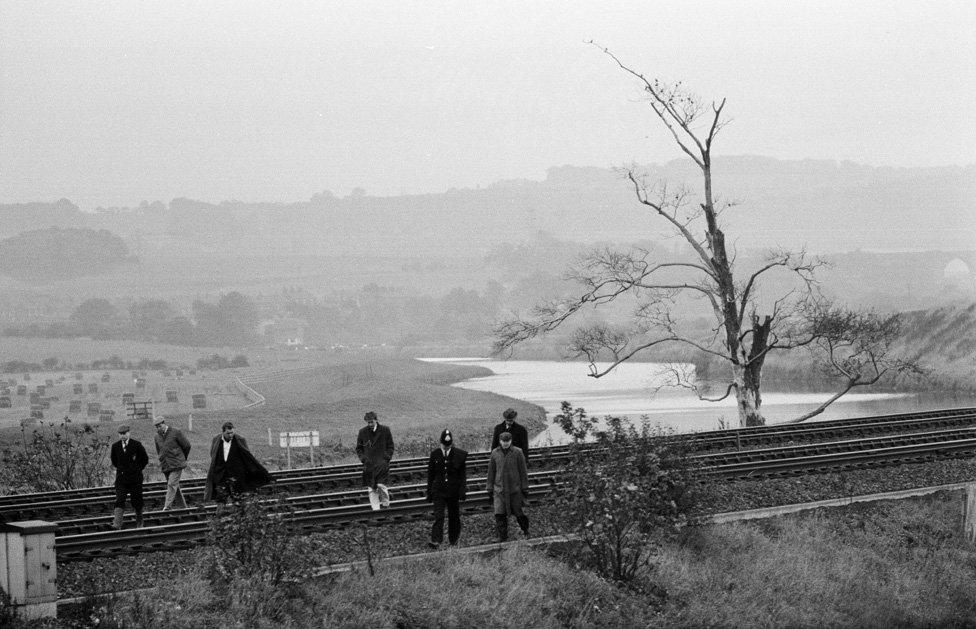
Police search a stretch of railway tracks
Four hundred people, who lived within a quarter of a mile of the murder, were traced and their movements checked. A large number of knives were taken and examined but it was not thought that the murder weapon was among them.
The police were unable to establish any "apparent reason or motive for the attack" and did not know whether "she was the intended victim or merely passing at the time". No one was traced "with the slightest animosity against the girl". There was no evidence of a sexual assault and no sign of her having been robbed.
No-one was ever convicted of her murder.
Precisely 49 years and 14 days later, Elsie's sister Anne sat down at her computer and typed an email to the BBC. She wrote: "Next year will be the 50th anniversary of the murder of my 14-year-old sister. The perpetrator has never been brought to justice and I feel sad about that."
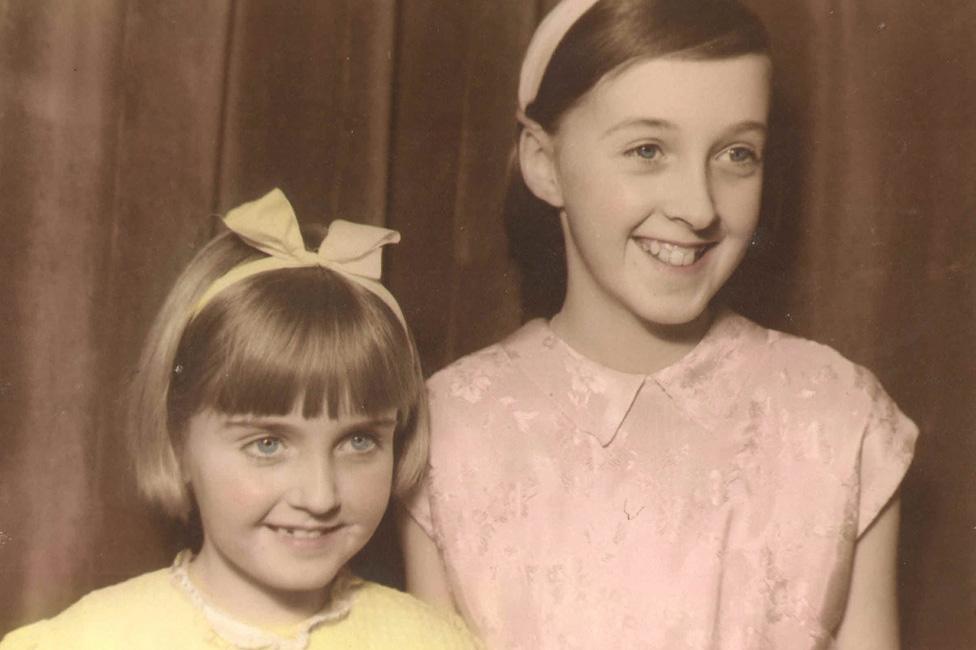
Childhood photo of Anne (right) with Elsie
Anne's sadness had not lessened as the years passed. To some extent, she had to keep her thoughts bottled up because she could not discuss the murder in front of her father. Arthur found it too upsetting. "He even found it difficult to talk about her and in fact we never did," Anne remembers.
Arthur could not even bring himself to look at photographs of Elsie. When Anne's parents died - Edith in 1988 and Arthur in 2003 - they both "went to their graves… feeling hugely guilty" because "they didn't know what had happened to their daughter", Anne says.
Anne is determined that she and her brother Colin will not have "that same kind of guilt that mum and dad had".
As a result of the email, Anne and Colin were interviewed on BBC Radio 4's iPM programme. They told their story and that of their murdered sister. The interview lasted around 19 minutes but can be summed up by 13 words spoken by Anne:
"Why? Why did it happen? On a Saturday afternoon at half past four?"
On 11 January 1966, around three months after the murder, an inquest jury thought it knew who had killed Elsie. These days an inquest's role is only to establish certain facts and the cause of a death. In 1966, an inquest could actually accuse a man of murder. And that is what happened at the inquest into the death of Elsie.
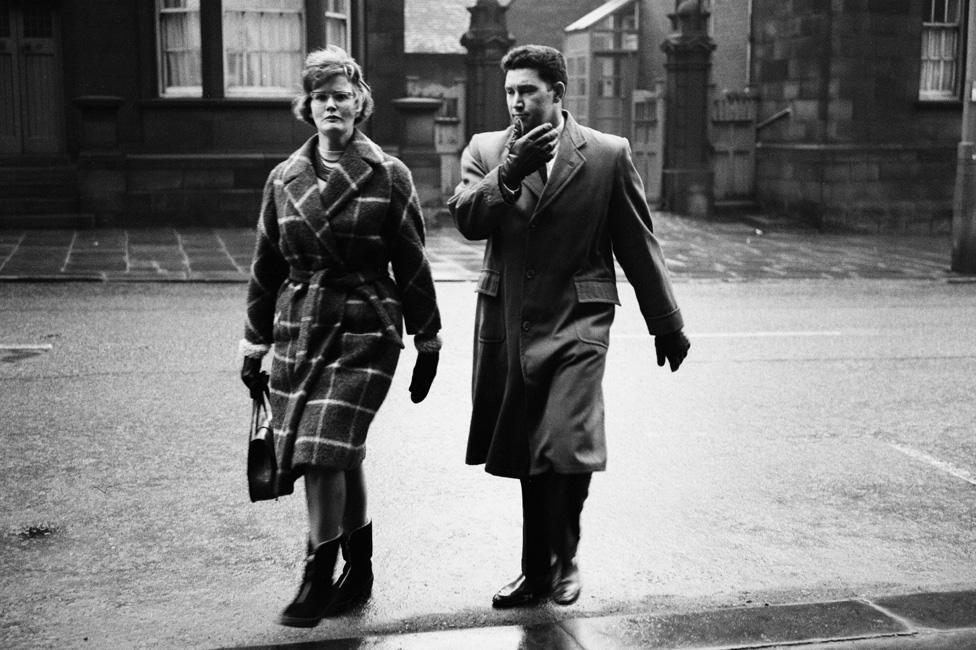
Ian Spencer and wife Margery arrive to give evidence at Elsie Frost's inquest
On the morning of 12 January, the Guardian's headline was: "Coroner sends man for trial on murder charge." The Mirror summed it up with the words: "Elsie: Man accused of murder."
The man was Ian Spencer, who had appeared at the inquest as a witness. The unanimous verdict of the jury was that Elsie Frost had been murdered and "that there is a prima facie case against Ian Bernard Spencer" - effectively accusing him of the crime.
Described in different reports as a former railway fireman and as a labourer, he was 33 and married with a son.
He had appeared as a witness at the inquest because he had been in the area of the murder on the same afternoon but he was insistent that he was at home quite some time before Elsie was killed. His wife, mother-in-law and a family friend said they were able to confirm that but they were not called by the coroner to speak at the inquest.
Some of the witnesses who were called contradicted that story and claimed they thought they saw him close to the area where Elsie's body was found.
Ian Spencer was committed to face trial. He spent eight weeks and two days in prison.
In March 1966 he was cleared. A magistrates' court had already concluded there was no case to answer and a judge at the equivalent of the modern crown court instructed the jury to find him "not guilty".
Elsie's mother Edith told newspapers: "I know what Mr Spencer and his wife must have suffered, I am glad for their sakes it is over. I am sure they will be as anxious as I am to have the killer found."
One of the people I spoke to over the past few months was Ian Spencer's son, Lee. His father is now in a care home and unable to communicate, after suffering a severe stroke, but Lee was keen to speak on his father's behalf. Lee has a series of his father's notebooks. Opening one at random, it listed places he had been, times and his mileage.
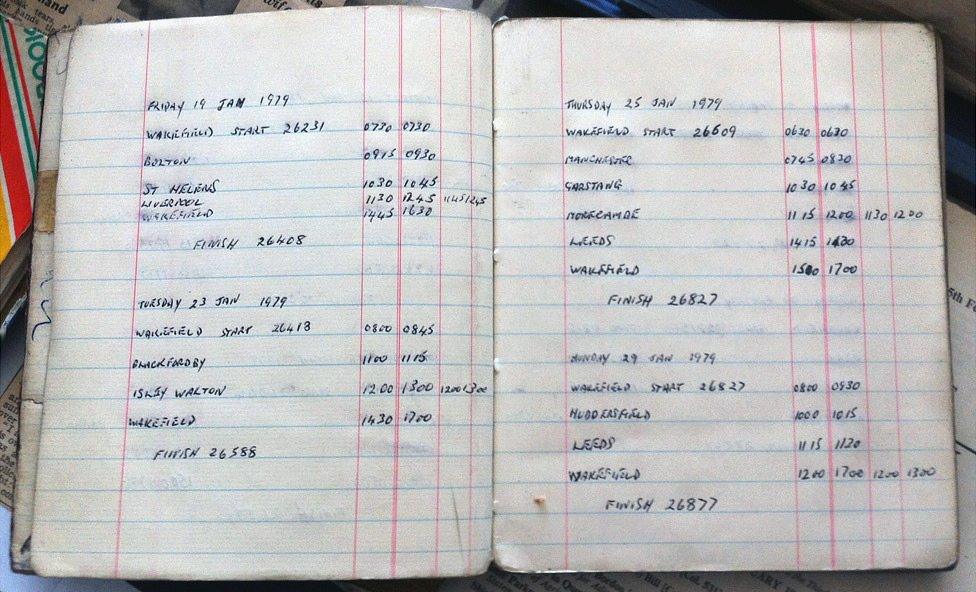
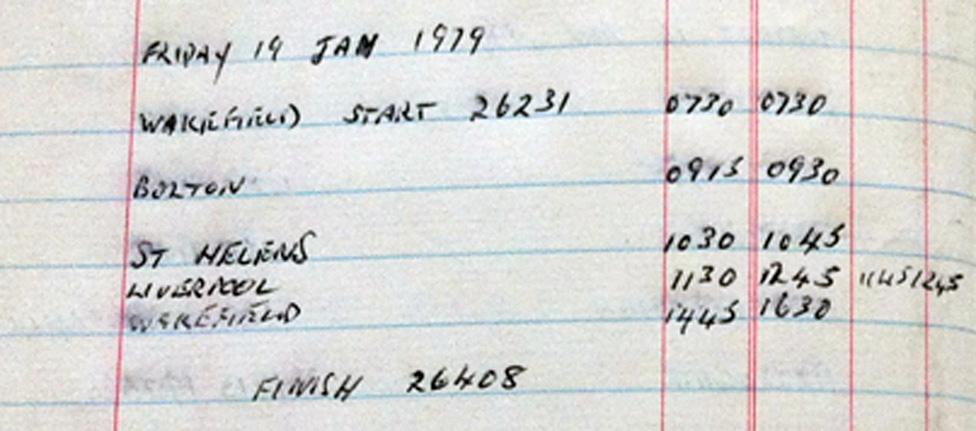
Every day, every week, every month, year after year, he wrote down everything - the moment he left, the moment he arrived and the moment he returned, wherever he went.
He did this throughout his working life and continued when he retired.
Finding the log books in his father's house was tough for Lee. "It's difficult to think that you've got to write this down, day after day," he says.
"He started logging things because of what people had said," says Ian Spencer's cousin, Brian Orange.
At various times during the following years, when there were other murders, the police would arrive at the family home to ask where Lee's father had been when those crimes had been committed. That still angers the family. They believe it was deeply unfair because he had been cleared by two courts.
Brian thinks it is likely that the police visits were one of the reasons his cousin started logging his life.
"With the police keeping coming back, he had it in his mind that he would need to be able to say, well, I left home, I went to work. He wanted a safeguard for himself."
Despite his acquittal, what happened "never left him over the last 50 years", as Lee puts it.
At every turn in reporting this story, I have found people whose lives have been permanently affected by what happened.
Let us return to Anne's questions. We were left with the knowledge that a teenager had been murdered and a man accused and acquitted of her killing. What though could we find out about the circumstances of Elsie's murder?
I discovered all those details about what Elsie was wearing that day - the red coat, yellow jumper and brand new shoes - in the file from the inquest.
One of the most difficult days emotionally was when I took Colin to the coroner's office in Wakefield. Staff had kindly retrieved the relevant documents from the archives.
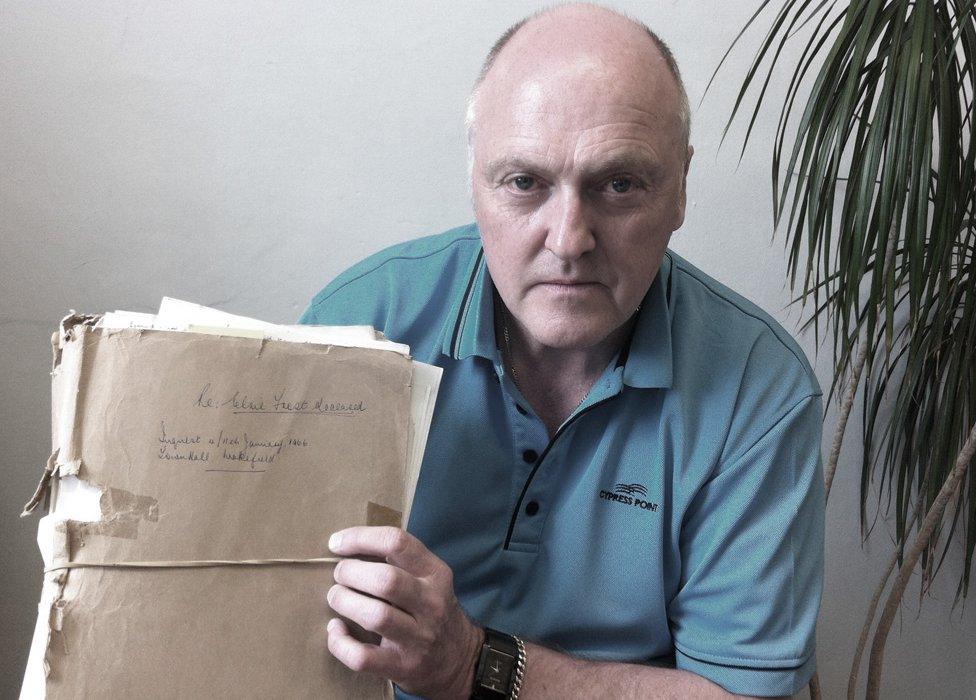
Colin Frost holding the inquest file
Before getting there, Colin told me he would definitely like to know when his sister was killed. The family had thought she died at about 16:30. The file suggests it was earlier than that.
There is a letter on the coroner's headed paper, which seems to have been typed by or on behalf of the Coroner's Officer, Gerard Browne, at 13:00 on Sunday 10 October 1965. It confirms Elsie's name, address and age and where she was found.
At the bottom of the page, there are some "special remarks". They begin: "Sir, the deceased girl was found [at] about 4.15pm, Saturday 9 October 1965."
For Colin, knowing this was important. And there was more in the file which was to be new to him.
The lake - or lagoon - where Elsie was sailing on the afternoon she died was known as the Horbury Sand Quarry. It is close to the River Calder, a canal and some railway lines.
To return home after sailing, Elsie would most likely have walked on a path which is not there anymore, fairly close to the railway. That area is now totally overgrown. There is another path, which is used now, closer to the canal.
To reach the other side of the railway, it is believed she headed for what is locally called the "ABC tunnel". There are then steps up a steep embankment. There are 26 of them, hence the "ABC".
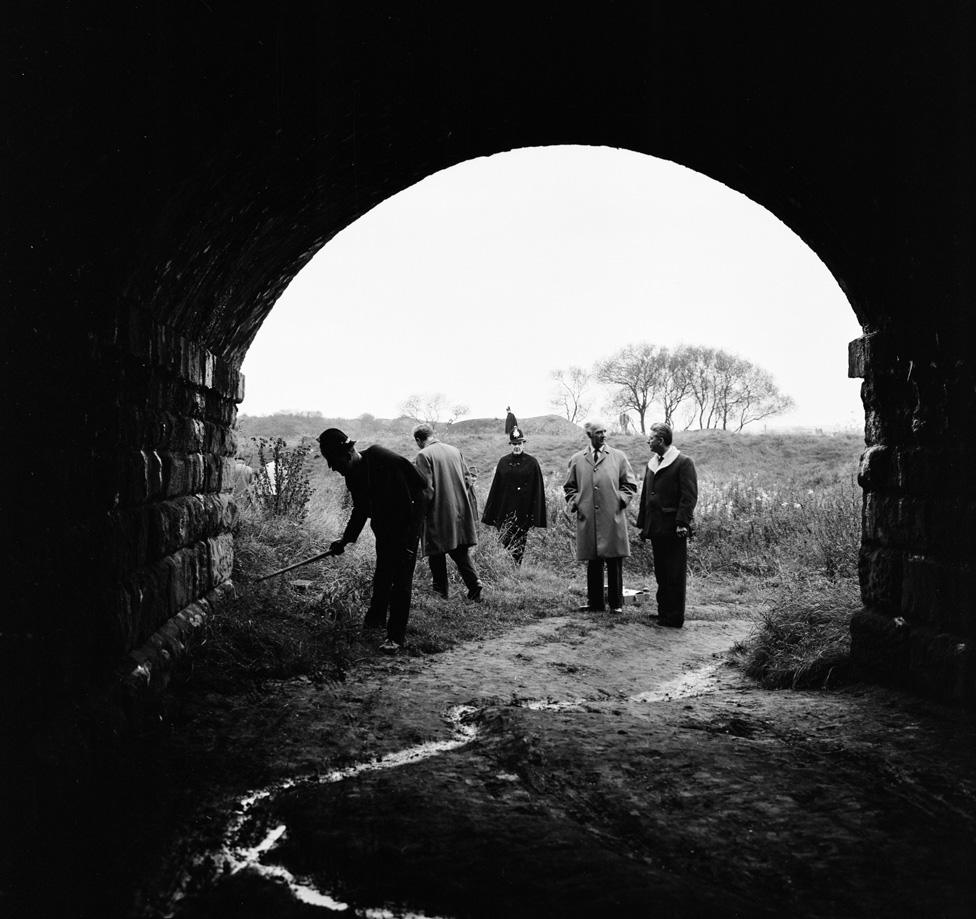
Police search the 'ABC' tunnel
Elsie's body was found by a man, Thomas Brown, who had been walking with his young children and their dog.
He told the inquest: "When we got to within five or 10 yards of the bottom of the steps, I saw a girl lain there, whom I now know to be Elsie Frost. She was lying with her left arm on the second step and her head was lying on her left arm and her right arm was above her head on the next step.
"She was crouched up in an awkward position with her legs underneath her body in a kneeling type of position but more on her left hand side. I went up to her and asked her what was wrong and got my hands under her armpits and picked her up.
"When I spoke to her I did not get any reply. I did not realise she was as badly injured as she was. At this time, my son was at the top of the banking. I tried to persuade the children to go home but they wouldn't."
There are also details in the file about what Elsie was doing within the hour leading up to her death. The event that afternoon at the lagoon was organised by her school's sailing club. The teacher in charge, John Blackburn, told the inquest: "I beckoned to Elsie and took her out in a boat to give her some instruction, as she had previously got into difficulties when navigating one of the boats.
"I was out with Elsie Frost in the boat until about five minutes to four."
He explained that Elsie had then helped him to pack the boats away before she left. Other children and another teacher then departed before Blackburn then left at about 16:20. If all the times in the inquest file are accurate, Elsie was killed between about 16:00 and 16:15.
While the police never found out what happened during that time, there is a woman who thinks she knows. Her name is Janis Hirst. Back then, her surname was Dixon and she was a friend of Elsie's.
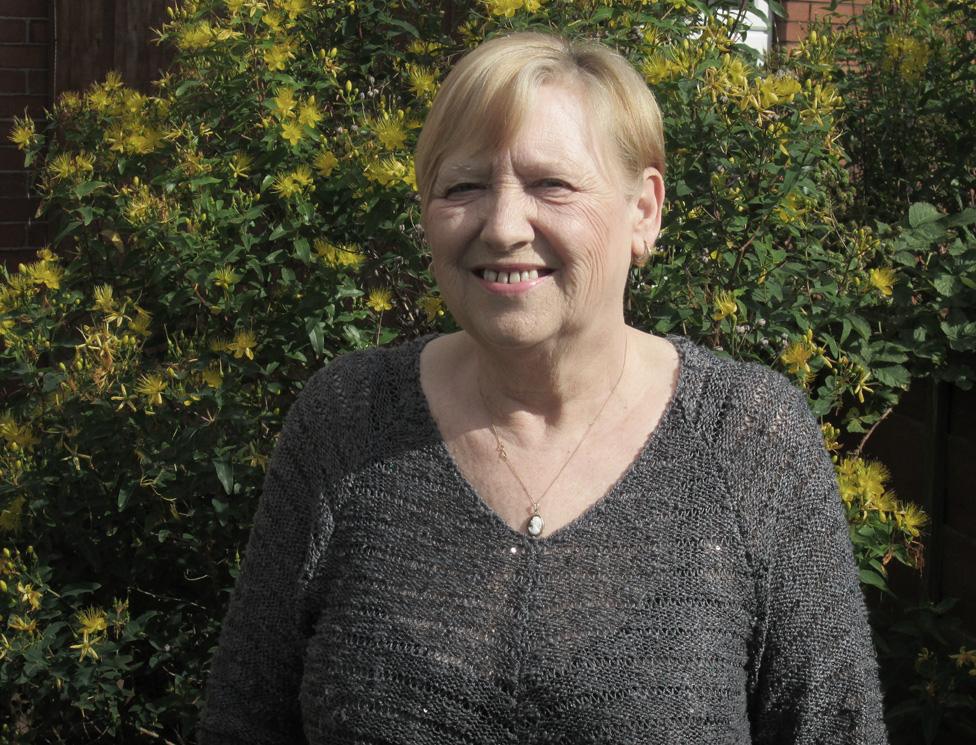
Janis Hirst
"When doing my nurse training, I was working at a hospital and got talking about Elsie on a shift we were on. And this nurse had said that she had worked in a hospital where a man had been brought in and he had confessed under drugs to being present at the murder of Elsie.
"He said that he was in the long grass with another man committing a homosexual act when Elsie had stumbled over them… and the other man had run off after Elsie and stabbed her. Elsie had caught them in the act and had run off screaming and he jumped Elsie and stabbed her."
According to Janis, the other nurse said a doctor was also in the room to hear this "confession". They did not tell the police because "whatever a patient tells you is strictly confidential and they couldn't break that confidentiality" and also because the man was on medication at the time.
The nurse who Janis said told her all of this died some years ago. Janis says she was given names for the two men but we are not publishing those for obvious legal reasons. She says she is willing to speak to the police.
Janis is confident that what she was told is true but, crucially, she was not there when the supposed confession happened. It is a third-hand story, so one which understandably does have to be treated with a high degree of caution. In legal terms, it would be considered as "double hearsay".
I have heard another story along the same lines. According to the former MP for the area, David Hinchliffe, there was a rumour at the time that Elsie had been killed because she had stumbled upon what people described as "homosexual activity". It's worth bearing in mind that homosexual acts between men were illegal until 1967.
Of course, when there is any unsolved murder, there will probably always be different stories going around about who might have been responsible. And most will probably not be true.
One of Anne's fears is that whoever was responsible might have gone on to attack others. A woman called Julie - she only wants us to use her first name - claims something happened to her in the same area nine years later. She was the same age as Elsie had been - 14.
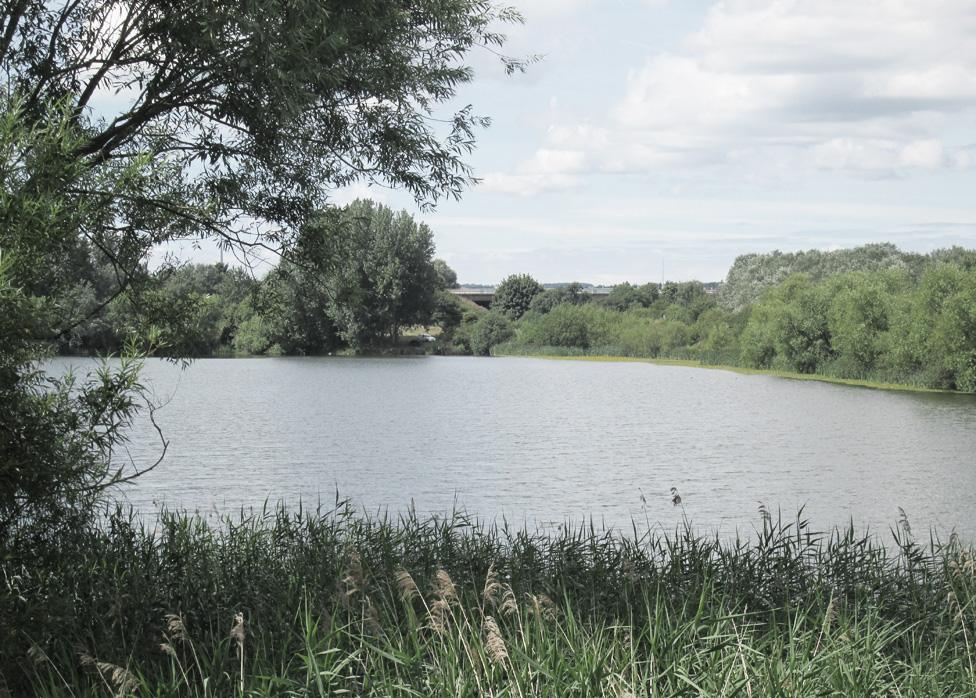
"We'd bunked off school - me and my brother and his friend and had gone down the quarry," she says. "We'd gone swimming. I was over at the jetty and I got jumped on by a man. He got me in the grass, got on top of me, his hand over my mouth, he slashed my shorts with his knife, he put the knife to my throat. My brother came along and his friend and chased him away."
Julie says she did not go to the police "because I should have been at school. I didn't even tell my mum". Julie's brother says he remembers there being some kind of incident but does not remember the knife and is short on detail.
It will be the task of a new police investigation to assess the stories of people like Janis and Julie. It is happening as a result of what we have been doing and it is the first investigation into the murder since the 1960s.
"The reason why I've taken on this investigation is that I want justice for Elsie," says West Yorkshire Police's DCI Elizabeth Belton.
She is to launch an appeal for information and has not ruled out the possibility that the person responsible might actually come forward to "clear their conscience and tell me that they've committed the murder and, more importantly, a reason why".
Unfortunately, DCI Belton will not be able re-examine all the evidence from the time.
We probably all have an image in our heads, fuelled by all those television dramas we have watched, of vast police storerooms, containing plastic bags full of potentially vital pieces of evidence going back decades.
But unsurprisingly the police officers in Wakefield in the mid-1960s did not anticipate the amazing scientific advances in DNA testing seen over the subsequent decades. In April 1966, just six months after the murder, some of Elsie's clothing was returned to her father and the rest was destroyed. None of it remains. There are no plastic bags of evidence awaiting the DNA expert.
Colin thinks of his sister every time he ties up his shoelaces. It was Elsie who taught him how to do it when he was a little boy. Fifty years after she was killed, she remains on people's minds and not only those of members of her family.
A few weeks ago, when I met Elsie's friend, Janis Hirst, she showed me an old black and white school photograph. Janis is standing in the third row. Elsie is a few places along to her left. Both are grinning.
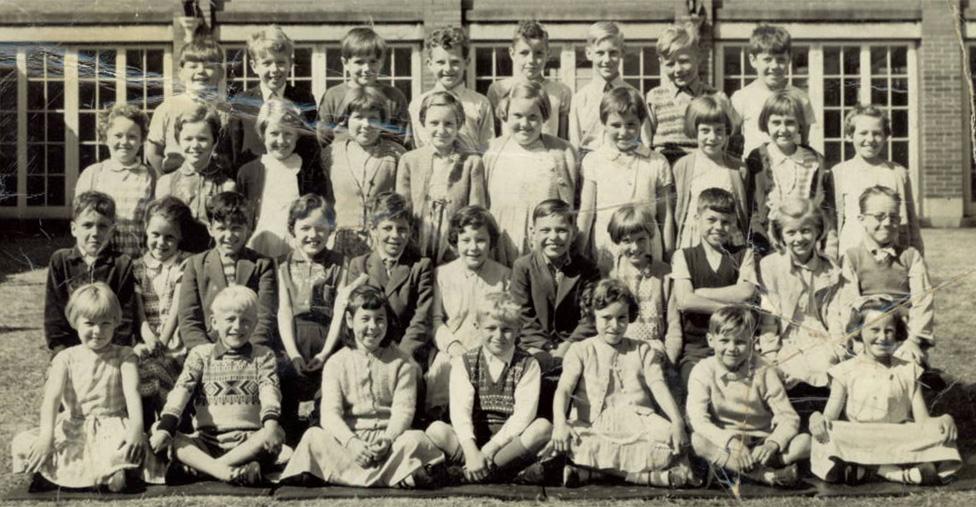
Like Elsie, Janis was a member of their school's sailing club. In fact, she was meant to have been going sailing with her on the afternoon she died. They had arranged to meet at about 14:00 in order to walk to the lagoon together. But that did not happen.
Janis did not turn up. Her mother was ill and she was sent to the shops instead. Her family did not have a telephone so she was unable to let Elsie know. If they had met up, they would almost certainly have left together too. That has haunted Janis ever since.
"I remember saying to two detectives who came to our house that if I'd had gone, it might not have happened because there'd have been two of us. And I remember them saying to me: 'It could've been that we would have been investigating two deaths. It could've happened to both of you so don't ever think that it was because you weren't there that it happened.'"
But that is exactly what has troubled Janis all of these years. As a result, she has written twice to Elsie "to apologise for not being there that day to walk home with her". She wrote the first letter when she was 16, the second when she was 40.

Elsie Frost
"I think it will always be that doubt in my mind," she says. "There's always that little girl inside of me who thinks I should have been there and it wouldn't have happened."
For Anne and Colin, the last few months have, at times, been very difficult. Anne says there were moments when she "wanted it all to stop". She had sleepless nights, and sometimes felt she "might be sinking underneath it" but says she needed to do something and that it had been worthwhile. After all, she says, "this has been on my mind for 50 years".
Anne's main question remains unanswered. Why did it happen?
The family does now have the new police investigation to give them the hope that the answers will eventually come but Anne admits there is a big risk that she might be left feeling disappointed.
When Colin went with me to the coroner's office in Wakefield, he came away with some of the details he wanted to know and with an image in his head. He says that helped.
"I feel inside actually closer to Elsie than I was. I can see Elsie's body, how it was dressed, the anorak, the shoes, the skirt, what she was carrying. The only thing that's missing on the body that I am picturing is I don't have her face."
But he says he would not want to see her face in that mental image.
On 9 October this year, half a century after she was killed, Elsie's life will be remembered in a special service at what used to be the family's local church in Wakefield.
Anne says that when she is sitting in the church, she will be thinking about her sister, all the people who "should have known her and who haven't known her" and all those "who have been affected [like] Janis [and] Mr Spencer. They will all be on my mind".
On the same day, a tree will be planted in Elsie's memory at the crematorium where her funeral took place. There will be a plaque with some words her family has written:
Elsie is remembered by her family, friends and the community of Wakefield.
Forever loved, forever remembered.
7 February 1951 - 9 October 1965.
You can listen to or download all the reports so far.
Subscribe to the BBC News Magazine's email newsletter, external to get articles sent to your inbox.